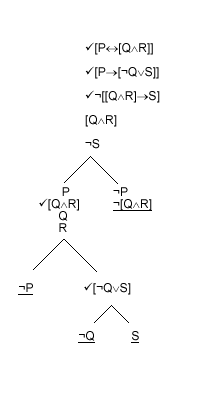| ||||||||||||||||||||||||||||||
Testing arguments for validity
The tableau method provides us with of way of testing for inconsistency. However we know that an argument is valid just if its counterexample set is inconsistent. So to test an argument for validity, we test its counterexample set for inconsistency.
So, suppose we have an argument which after formalisation gives us:
[P«[QÙR]], [P®[¬QÚS]]. So, [[QÙR]®S]
Remember that the counterexample set consists of the premises together with the negation of the conclusion. To get the negation of the conclusion we just put "¬" in front of it.
So the counterexample set of our argument is
{[P«[QÙR]], [P®[¬QÚS]], ¬[[QÙR]®S]}
Here is the tableau:
 |
The tableau closes. So, the counterexample set is inconsistent. So, the argument is valid.
Summary of the tableau method
1 Translate the English sentences using truth-functors of the propositional language.
2 Abbreviate the short English sentences with single letters.
(The key is called an interpretation;
The resulting string of letters and truth-functors is a formula.)
3 Construct the tableau:
(a) List the formulae at the top
(b) Develop the tableau by the derivation rules
(c) Close (by underlining) any branch with both "φ" and "¬φ".
4 Check for consistency:
(a) If all the branches are closed the set is inconsistent.
(b) If a branch is open check its unticked formulae for consistency using the interpretation.
If they are inconsistent the branch is impossible.
(c) If all the open branches are impossible the set is inconsistent.
|
To test an argument, P1, P2,..., Pn, so C, for validity:
test {P1, P2,..., Pn, ¬C} for inconsistency. (If this counterexample set is inconsistent, the argument is valid.) |
| Print this page |